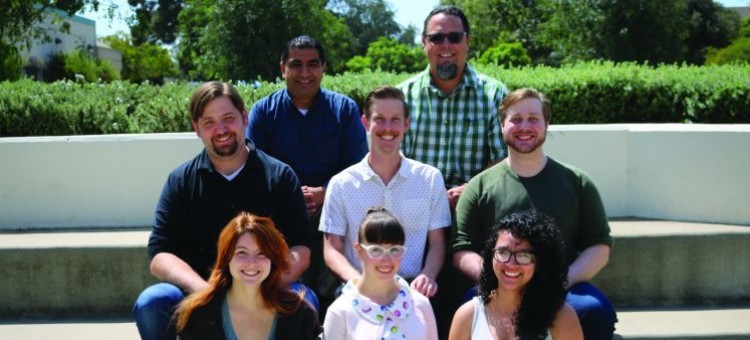“My sister was a burgeoning graphic designer, and through her contacts I was hired as a paste-up artist for a local classified,” recalls Rivera, supervisor of Campus Graphics at Allan Hancock College, in Santa Maria, Calif. “Since then, most every job I have held has been in screen printing, prepress, sheetfed or in graphic design.”

Staff and student workers at Allan Hancock College Campus Graphics. Front row, from left: Jessica Dugan, Lauren Dubose and Elizabeth Zuniga. Middle row: Matthew Macpherson, Robert Nourse and Nicholas Ungefug. Top row: Josue Santos and Gordon Rivera.
For the past 22 years, Rivera has worked in the in-plant at Allan Hancock College, starting as an offset technician in 1996 and moving into his current role overseeing a team of five, plus two student volunteers.
“It’s the best team I have had since I’ve been here,” he praises. “The level of talent … they are incredible.”
The in-plant reports to marketing, and its customers include faculty, staff, administration, student services and the shop’s highest volume customer, the college’s advancement departments and programs.
“Our jobs consist of lots of collateral material, brochures and marketing pieces. This consumes most of our resources and time,” Rivera says. “We also do a lot of academic printing: exams, syllabi, handouts and course packs.”
Campus Graphics prints this work on its two Canon imagePRESS C800/C700 digital color presses and two Océ Varioprint 110 black-and-white digital printers.
“Wide-format is off the chart,” he adds. “We print everything from mounted posters and banners to pop-up displays, flags and high-end canvas prints. This is the part of the print industry that is really taking off.”
To do this work, the shop uses an HP Latex 360 and an Epson Stylus Pro 7890. To cut and mount wide-format prints, the in-plant uses a Rollsroller flatbed applicator, a 65˝ Fletcher FSC wall cutter and a 120˝ Foster Keencut rotary cutter. This combined with the in-plant’s other creasing, folding, cutting and laser engraving equipment makes for very tight quarters.
“We have all this in 2,200 sq. ft. of space. They call us the “Crampus” Graphics Department,” Rivera jokes.
Taking in Outside Work
The in-plant is always looking for new business to keep that equipment busy, including by insourcing from outside the college.
“One of the unique things that we do is we take on quite a bit of work for select non-profits in the area like foundations and chambers,” Rivera says. “If we didn’t do the printing for these groups at the prices we offer, they may not be able to afford to have the printing done. And we’re able to take cash payments or credit cards all through Print Shop Pro.”
Print Shop Pro (PSP), from edu Business Solutions, is the in-plant’s print management software, with Web-to-print and document conversion capabilities. The system can even be used to bill for non-print services, such as when the in-plant offers its design and consulting services to outside entities.
“If another school needs brochures or assistance with a re-branding or service outside of the scope of their expertise, they can use our resources and skills to get the work done, and we simply charge by the hour and bill through Print Shop Pro,” explains Gordon.
On average the shop prints 6 million impressions each year.
“We have grown our print volume significantly using PSP,” he says. “When we first installed PSP it took us seven years to get to 100,000 jobs. It has taken only four years to get to 200,000 jobs, so that speaks to the exponential growth we have achieved using PSP. Our work doubled in almost half of the time. We wouldn’t be where we are today without PSP.”
It has allowed the in-plant to capture $231,788 in chargebacks, Rivera says, and the shop has increased its total revenue by 72% from last year by utilizing PSP for order intake and invoicing.
Moving From Manual Processes
Rivera was actively involved in vetting the software in 2006. At the time, the in-plant used NCR forms to receive and process orders. There was no way to track orders, inventory or the true cost of what the shop was providing customers. As the shop’s volume grew, it transitioned to an Excel-based order form.
“The Excel form worked well, but we had no way to track orders for customers,” Rivera recalls. “We lacked the data and resources to really gauge our growth and the quality of what we were providing. PSP was the only solution at the time that had the necessary bones to meet our need of 100% online intake of jobs and the ability to track orders and report on our results all in one system.”
Campus Graphics purchased PSP in March of 2007.
“Again, if it wasn’t for PSP we wouldn’t be where we are today,” Rivera praises. “The data we are able to pull out of the system enables us to justify or quantify changes. It’s critical for proving our livelihood as in-plants. PSP gives us tremendous tools.
“About a year and one half ago we went from a non-chargeback system to 100% chargeback and we were able to do that easily with PSP,” he continues. “We can pull reports to turn in to our parent organization. Without this ability we have no bargaining chips to get the resources we need. We have to know how much things cost and how much we are providing or not providing. All of our records, retail data and interior chargebacks are managed in PSP. If it wasn’t for the robust nature of the system we may not have been able to get new equipment or hire new staff. PSP is our partner in Campus Graphics, not just a supplier or vendor.”
As soon as he graduated high school, Gordon Rivera stepped into the graphic arts world.
“My sister was a burgeoning graphic designer, and through her contacts I was hired as a paste-up artist for a local classified,” recalls Rivera, supervisor of Campus Graphics at Allan Hancock College, in Santa Maria, Calif. “Since then, most every job I have held has been in screen printing, prepress, sheetfed or in graphic design.”
For the past 22 years, Rivera has worked in the in-plant at Allan Hancock College, starting as an offset technician in 1996 and moving into his current role overseeing a team of five, plus two student volunteers.
“It’s the best team I have had since I’ve been here,” he praises. “The level of talent … they are incredible.”
The in-plant reports to marketing, and its customers include faculty, staff, administration, student services and the shop’s highest volume customer, the college’s advancement departments and programs.
“Our jobs consist of lots of collateral material, brochures and marketing pieces. This consumes most of our resources and time,” Rivera says. “We also do a lot of academic printing: exams, syllabi, handouts and course packs.”
Campus Graphics prints this work on its two Canon imagePRESS C800/C700 digital color presses and two Océ Varioprint 110 black-and-white digital printers.
“Wide-format is off the chart,” he adds. “We print everything from mounted posters and banners to pop-up displays, flags and high-end canvas prints. This is the part of the print industry that is really taking off.”
To do this work, the shop uses an HP Latex 360 and an Epson Stylus Pro 7890. To cut and mount wide-format prints, the in-plant uses a Rollsroller flatbed applicator, a 65˝ Fletcher FSC wall cutter and a 120˝ Foster Keencut rotary cutter. This combined with the in-plant’s other creasing, folding, cutting and laser engraving equipment makes for very tight quarters.
“We have all this in 2,200 sq. ft. of space. They call us the “Crampus” Graphics Department,” Rivera jokes.
Taking in Outside Work
The in-plant is always looking for new business to keep that equipment busy, including by insourcing from outside the college.
“One of the unique things that we do is we take on quite a bit of work for select non-profits in the area like foundations and chambers,” Rivera says. “If we didn’t do the printing for these groups at the prices we offer, they may not be able to afford to have the printing done. And we’re able to take cash payments or credit cards all through Print Shop Pro.”
Print Shop Pro (PSP), from edu Business Solutions, is the in-plant’s print management software, with Web-to-print and document conversion capabilities. The system can even be used to bill for non-print services, such as when the in-plant offers its design and consulting services to outside entities.
“If another school needs brochures or assistance with a re-branding or service outside of the scope of their expertise, they can use our resources and skills to get the work done, and we simply charge by the hour and bill through Print Shop Pro,” explains Gordon.
On average the shop prints 6 million impressions each year.
“We have grown our print volume significantly using PSP,” he says. “When we first installed PSP it took us seven years to get to 100,000 jobs. It has taken only four years to get to 200,000 jobs, so that speaks to the exponential growth we have achieved using PSP. Our work doubled in almost half of the time. We wouldn’t be where we are today without PSP.”
It has allowed the in-plant to capture $231,788 in chargebacks, Rivera says, and the shop has increased its total revenue by 72% from last year by utilizing PSP for order intake and invoicing.
Moving From Manual Processes
Rivera was actively involved in vetting the software in 2006. At the time, the in-plant used NCR forms to receive and process orders. There was no way to track orders, inventory or the true cost of what the shop was providing customers. As the shop’s volume grew, it transitioned to an Excel-based order form.
“The Excel form worked well, but we had no way to track orders for customers,” Rivera recalls. “We lacked the data and resources to really gauge our growth and the quality of what we were providing. PSP was the only solution at the time that had the necessary bones to meet our need of 100% online intake of jobs and the ability to track orders and report on our results all in one system.”
Campus Graphics purchased PSP in March of 2007.
“Again, if it wasn’t for PSP we wouldn’t be where we are today,” Rivera praises. “The data we are able to pull out of the system enables us to justify or quantify changes. It’s critical for proving our livelihood as in-plants. PSP gives us tremendous tools.
“About a year and one half ago we went from a non-chargeback system to 100% chargeback and we were able to do that easily with PSP,” he continues. “We can pull reports to turn in to our parent organization. Without this ability we have no bargaining chips to get the resources we need. We have to know how much things cost and how much we are providing or not providing. All of our records, retail data and interior chargebacks are managed in PSP. If it wasn’t for the robust nature of the system we may not have been able to get new equipment or hire new staff. PSP is our partner in Campus Graphics, not just a supplier or vendor.”
Reposted with permission from In-plant Graphics Magazine.

Recent Comments